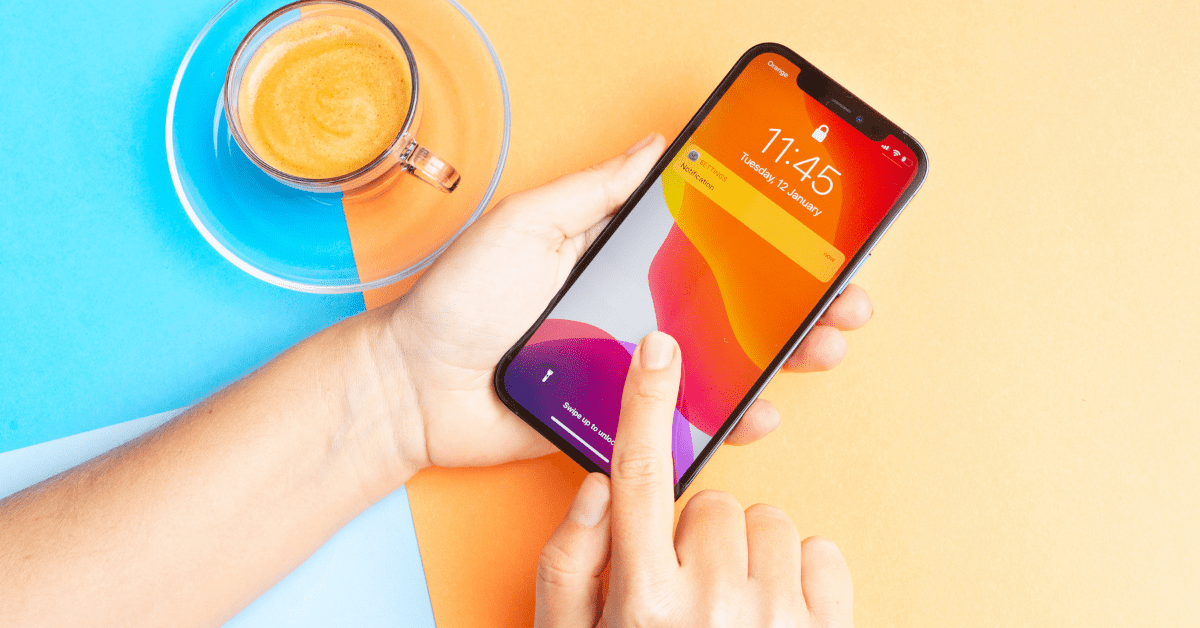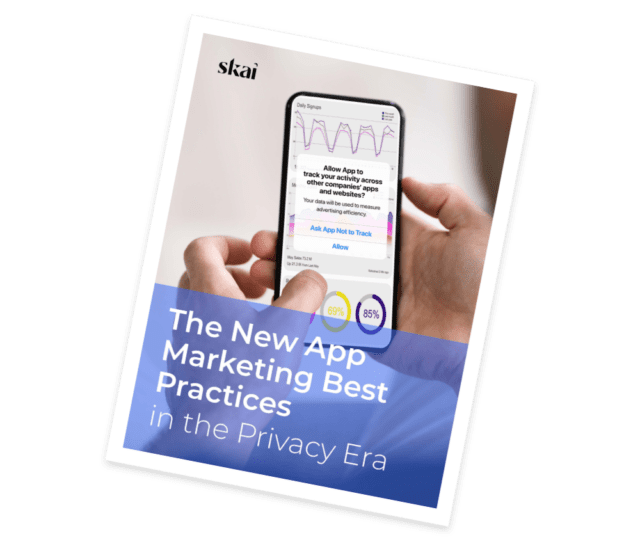
Joshua Dreller
Sr. Director, Content Marketing @ Skai

Joshua Dreller
Sr. Director, Content Marketing @ Skai

It’s safe to say that we’re well past “there’s an app for that.” In an increasingly digital world, it’s weirder when there isn’t a mobile app. As a result, digital marketing efforts have shifted to downloads and lifetime value.
Let’s analyze the trends that have shaped mobile app marketing over the past few years and how savvy marketers have adapted to continue to create success even in the face of new challenges, like App Tracking Transparency (ATT). You can follow down the blog or jump to a specific section with our table of contents.
Mobile app marketing is an avenue that brands take to drive customers to download and use their mobile apps. It doesn’t stop at getting a download; mobile app marketing includes campaigns that drive downloads and retain users. Mobile app marketing spans the entire lifetime of an app and should focus on engaging users in both app stores and within the app itself once it’s been downloaded.
The most apparent driver of better marketing strategies around mobile applications is the steady uptick in mobile device use. This graph from eMarketer shows a steady decline in daily television watching and an equally steady increase in daily mobile device use. It’s important to note that this graph is a projection made in 2019 (pre-pandemic), and it didn’t get everything right. It was right about there being an increase, and the following market trends are still relevant today.
More interestingly, this data reveals that users spent 78.4% of their device time in apps, a whopping 2 hours and 55 minutes of their day. The data proves plenty of value to be found in investing in a mobile app. Here are three things to keep in mind when you’re strategizing.
Ten years ago, Apple’s App Store had approximately 500 apps. A company that built an app was a novelty; many users would download it to see what it did. These days, there are upwards of 2 million apps in the App Store. Your customers have a lot of options.
Here’s the good news: If your app provides value, your customers will be more likely to use it. According to a recent study, consumers are downloading retailer’s mobile apps at double the rate of years past and conducting more in-app purchases. Specifically, 67% of consumers have downloaded a mobile app from a retailer within the past year. And further research shows that 57% have used a retailer’s app while in the store.
Getting people to continue to use your app after downloading it can be a challenge; about 80% of all app users churn within the first 90 days of downloading a new app. And while, of course, attracting new users to the app should be a priority, studies show that the top 20% of successful companies are the ones that focus on lifetime value rather than last-touch metrics such as conversions and ROI.
What often causes an uninstall is a lack of scope or a lack of support: Failing to make an app customer-centric and valuable and making a brand-focused experience is a common pain point with customers. If and when you decide to launch a mobile app, keeping customer value top of mind is the best strategy.
Remember how we pointed out that our emarketer graph from the last section was a projection made in 2019? It wasn’t that far off, but the sudden change in our daily lives led the estimates to move to upwards of 4 hours a day spent on mobile internet, solidifying that mobile apps are a reliable channel to reach customers.
You could call the beginning of the pandemic a peak for the mobile app market. While mobile app marketing certainly isn’t dead, a lot has changed since the data used in this section, which came out in 2020, was published. However, the boom showed marketers what works and what doesn’t in the mobile app game, and that information is no less accurate now.
The most obvious advantage to increased phone use is more opportunities to capitalize on mobile applications. It also means that in order to remain competitive, it’s vital for brands to engage more with users using this channel.
One of the more interesting attributes of the app landscape is a much more open playing field than the brick-and-mortar retail space. Because of that, market challengers sometimes bank their entire growth strategy on app adoption first. If they can get consumers to use their app, the business can branch out from there, so app marketing is not just a best practice, but a core strategy.
With more people downloading and using apps at this time, the opportunity for new brands to fast-track their success via the app channel during COVID-19 was a real trend. For challenger brands, it was an opportunity they must try to maximize. For category leaders, this was a threat to their dominance.
Getting a consumer to download your app is one thing, but getting them to use it is another. With most apps relying on in-app transactions to be profitable, driving engagement and usage must be an important focus.
“The average app loses 77% of its DAUs [daily average users] within the first 3 days after the install. Within 30 days, it’s lost 90% of DAUs. Within 90 days, it’s over 95%. Stunning. The other way to say this is that the average app mostly loses its entire user base within a few months, which is why of the >1.5 million apps in the Google Play store, only a few thousand sustain meaningful traffic.”
If your app doesn’t get used, then it has zero value to your business. Apps shouldn’t be marketed like a product with a one-time sale. Apps should be marketed like a subscription service that knows that it must keep hammering home the value to its audience for repeat purchases or like a restaurant that wants its customers to keep coming back to eat.
Marketers can use channels such as Search and Social advertising to retarget downloaders of their apps with “deep links” that take users to a specific page on a website or a precise location within an app. This can encourage re-installs and app usage. For example, game app marketers can let people know that new characters and playable levels have been recently added. Food delivery and retail apps can promote discounts and deals.
The pandemic accelerated growth in the mobile app market, and fast-tracked it from being a possible avenue to a must-have for many brands. This sets the stage for act three, where a twist sets up the modern mobile app marketing landscape.
To summarize, mobile applications offer significant value, but to realize it, you must ensure that value goes both ways: Yours and your customers.
With more than 1 billion people worldwide on iPhones, Apple’s move last year to restrict the way app developers and marketers could track consumers may be the most significant shift in mobile marketing’s history to date. The loss of this signal from its AppTrackingTransparency (ATT) policy was a heavy blow for any company that relied on this data for a myriad of uses across targeting, personalization, measurement, and optimization.
While all businesses with apps were impacted, it’s the app-first brands that woke up that day in April 2022 to find that the world had forever changed. With iPhones representing nearly half of all smartphones in the U.S., they would need to find new ways to do business on the mobile web.
“It was like a light went off for app marketing,” says Hawley Shpiro, Head of U.S. App Strategy at Skai. “To say that this is one of the biggest shifts ever to mobile advertising would be an understatement.”
Now, almost a year later, app marketers are moving forward with a new set of best practices to continue driving the performance goals of their campaigns.

Before ATT, users could opt-out of [IDFA-based] tracking, but after the change, they now must opt-in to enable brands to track them. While the numbers vary by study — some say just 4% of users choose to opt-in while others show as high as 38% — the fact is that pre-ATT tracking enabled app marketers to target, personalize, measure, and optimize their campaign activity with deep granularity.
The following best practices are some of the ways that app marketers have adapted to this major industry shift:

One of the best ways to help users decide if they want to enable tracking is to give them a good reason. Marketers may not realize that they can customize some of the messages in the pop-up to consumers better understand how the app is going to use the data. This can help increase your opt-in rates.
Over the last 20 years, traditional [offline] marketers have sometimes criticized online marketers for relying too heavily on uninspiring, programmatic tactics to drive one-time consumer action and not enough focus on building their brands which can impact long-term consumer behavior.
We know that brand building has been proven over decades of studies to increase awareness, trust, loyalty, and myriad other benefits. Ultimately, having a solid brand has proven to impact the bottom line, just not in the instantaneous way that direct response (DR) advertising does. Some marketers even call brand marketing delayed response as a complimentary term to direct response marketing.
Building your brand with consumers can help lift the rest of your advertising’s response and conversion rates in a post-ATT world.
Pre-ATT, many app install ads focused on getting users to the app install page. There, your content on the product page, videos, reviews, and even ad variations using Custom Product Pages could make a compelling case for why the user should ultimately install the app. If the user didn’t install on that visit, it wasn’t that big of a deal because retargeting could be used to keep nurturing that user until the installation occurred.
In a post-ATT world, your app ads need to carry a bit more of the work. Instead of just working to fill the funnel and turning over the bulk of install conversion responsibility to retargeting campaigns, your ads have to do more of the “selling” as well.
Broaden your app’s creative ad strategy to be more inclusive of all types of people: those who have your app installed, those who have had it but uninstalled it, and those who are entirely new to your brand.
Many app marketers have reported that sales numbers have been maintained even while reporting has suffered. “Despite the data loss in-platform, real-world sales and revenue data is proving to be higher and in line with business goals, making it more important for advertisers to measure beyond platform data,” said one industry exec.
The problem is that no one knows just how far off their reporting is. In a September 2021 post, Facebook’s Vice President of Product Marketing Graham Mudd addressed this:
Our estimate is that in aggregate we are underreporting iOS web conversions by approximately 15%; however there is a broad range for individual advertisers. We believe that real world conversions, like sales and app installs, are higher than what is being reported for many advertisers. We are committed to helping you better measure these outcomes and improve your performance.
As these reporting issues are resolved, look at your final conversion activity to understand if your marketing is working.
Digital advertising has constantly been in flux since its inception two decades ago. So, it makes sense to adapt to industry changes when possible. But, at what point does the old way become too complex or impossible to keep going, and adapting to the change is needed?
Successful app marketers aren’t focused on combating ATT; they are adapting to it. Of course, this may be easier said than done. However, being able to let go of the frustration and focus on the job at hand is helping app marketers move on from this shift.
As part of Skai’s intelligent marketing platform, our App Marketing solution helps your app stand out among millions in the top stores with Apple Search Ads, Google Universal App Campaigns, and more. Skai leverages an advanced algorithm based on AI and machine learning to ensure your ads reach your target users. Increase installs and user acquisition with streamlined automation, optimization, and reporting.
You are currently viewing a placeholder content from Instagram. To access the actual content, click the button below. Please note that doing so will share data with third-party providers.
More InformationYou are currently viewing a placeholder content from Wistia. To access the actual content, click the button below. Please note that doing so will share data with third-party providers.
More InformationYou are currently viewing a placeholder content from X. To access the actual content, click the button below. Please note that doing so will share data with third-party providers.
More Information